Spark 运行架构核心总结
摘要:
1.基本术语
2.运行架构
2.1基本架构
2.2运行流程
2.3相关的UML类图
2.4调度模块:
2.4.1作业调度简介
2.4.2任务调度简介
3.运行模式
3.1 standalone模式
4.RDD实战
总结:
- 基本术语:
- Application:在Spark 上建立的用户程序,一个程序由一个驱动程序(Driver Program)和集群中的执行进程(Executer)构成。
- Driver Program:运行应用程序(Application)的main函数和创建SparkContext的程序。
- Executer:运行在工作节点(Work Node)上的进程。Executer负责运行任务(Task)并将各节点的数据保存在内存或磁盘中。每个应用程序都有自己对应Executer
- Work Node:集群中运行应用程序(Applicatuon)的节点
- Cluster Manager: 在集群上获取资源的外部服务(如Standalone,Mesos,Yarn),称作资源管理器或集群管理器
- Job: 包含多个Task的并行计算,往往由Spark Action(如save,collect)触发生成,一个Application中往往会产生多个Job
- Stage:每个Job被分成了更小的任务集合(TaskSet),各个阶段(Stage)相互依赖
- Task:被发送到某一个Executer的工作单元
- DAGScheduler:基于Stage的逻辑调度模块,负责将每个Job分割成一个DAG图
- TaskScheduler:基于Task的任务调度模块,负责每个Task的跟踪和向DAGScheduler汇报任务执行情况
2.运行架构
2.1基本架构:
图示:
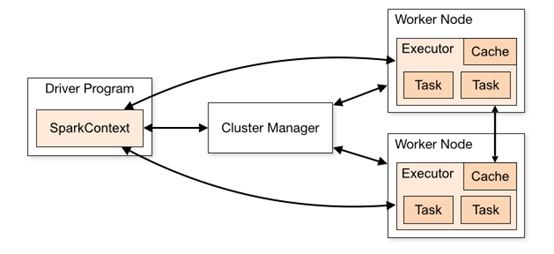
Spark Application在集群中以一组独立的进程运行,通过你的驱动程序(driver program)中的SparkContext 对象进行协作。
具体来说,SparkContext可以连接到多种类型的集群管理器 cluster managers (standalone cluster manager, Mesos ,YARN),这些 cluster managers 负责跨应用程序分配资源。一旦连接,Spark就获得集群中的节点上的executors,接下来,它会将应用程序代码发送到executors。最后,SparkContext发送tasks到executors运行。
注意:该驱动程序会一直监听并接受其executor传入的连接(spark.driver.port在网络配置部分)。这样,driver program必须可以寻找到工作节点的网络地址。数据不能跨应用程序(SparkContext)访问,除非写入外部系统
2.1.1 SparkContext类(代表连接到spark集群,现在一个jvm只能有一个sc,以后会取消):
几个重要的属性(包含DAGScheduler,TaskScheduler调度,获取executor,心跳与监听等):
说明:这里的下划线_代表默认值,比如Int 默认值就是0,String默认值就是None 参考知乎
/* ------------------------------------------------------------------------------------- * | Private variables. These variables keep the internal state of the context, and are | | not accessible by the outside world. They're mutable since we want to initialize all | | of them to some neutral value ahead of time, so that calling "stop()" while the | | constructor is still running is safe. | * ------------------------------------------------------------------------------------- */ private var _conf: SparkConf = _ private var _eventLogDir: Option[URI] = None private var _eventLogCodec: Option[String] = None private var _env: SparkEnv = _ private var _jobProgressListener: JobProgressListener = _ private var _statusTracker: SparkStatusTracker = _ private var _progressBar: Option[ConsoleProgressBar] = None private var _ui: Option[SparkUI] = None private var _hadoopConfiguration: Configuration = _ private var _executorMemory: Int = _ private var _schedulerBackend: SchedulerBackend = _ private var _taskScheduler: TaskScheduler = _ private var _heartbeatReceiver: RpcEndpointRef = _ @volatile private var _dagScheduler: DAGScheduler = _ private var _applicationId: String = _ private var _applicationAttemptId: Option[String] = None private var _eventLogger: Option[EventLoggingListener] = None private var _executorAllocationManager: Option[ExecutorAllocationManager] = None private var _cleaner: Option[ContextCleaner] = None private var _listenerBusStarted: Boolean = false private var _jars: Seq[String] = _ private var _files: Seq[String] = _ private var _shutdownHookRef: AnyRef = _
2.1.2 Executor(一个运行任务的线程池,通过RPC与Driver通信):
心跳报告(心跳进程,记录心跳失败次数和接受task的心跳):
这里有两个参数:spark.executor.heartbeat.maxFailures = 60,spark.executor.heartbeatInterval = 10s,意味着最多每隔10min会重新发送一次心跳
/** Reports heartbeat and metrics for active tasks to the driver. */
private def reportHeartBeat(): Unit = {
// list of (task id, accumUpdates) to send back to the driver
val accumUpdates = new ArrayBuffer[(Long, Seq[AccumulatorV2[_, _]])]()
val curGCTime = computeTotalGcTime()
for (taskRunner <- runningTasks.values().asScala) {
if (taskRunner.task != null) {
taskRunner.task.metrics.mergeShuffleReadMetrics()
taskRunner.task.metrics.setJvmGCTime(curGCTime - taskRunner.startGCTime)
accumUpdates += ((taskRunner.taskId, taskRunner.task.metrics.accumulators()))
}
}
val message = Heartbeat(executorId, accumUpdates.toArray, env.blockManager.blockManagerId)
try {
val response = heartbeatReceiverRef.askWithRetry[HeartbeatResponse](
message, RpcTimeout(conf, "spark.executor.heartbeatInterval", "10s"))
if (response.reregisterBlockManager) {
logInfo("Told to re-register on heartbeat")
env.blockManager.reregister()
}
heartbeatFailures = 0
} catch {
case NonFatal(e) =>
logWarning("Issue communicating with driver in heartbeater", e)
heartbeatFailures += 1
if (heartbeatFailures >= HEARTBEAT_MAX_FAILURES) {
logError(s"Exit as unable to send heartbeats to driver " +
s"more than $HEARTBEAT_MAX_FAILURES times")
System.exit(ExecutorExitCode.HEARTBEAT_FAILURE)
}
}
}
Task管理(taskRunner类的启动,停止)
// Maintains the list of running tasks. private val runningTasks = new ConcurrentHashMap[Long, TaskRunner]
下面是TaskRunner 的run方法,贴出来,以后研究
override def run(): Unit = {
val taskMemoryManager = new TaskMemoryManager(env.memoryManager, taskId)
val deserializeStartTime = System.currentTimeMillis()
Thread.currentThread.setContextClassLoader(replClassLoader)
val ser = env.closureSerializer.newInstance()
logInfo(s"Running $taskName (TID $taskId)")
execBackend.statusUpdate(taskId, TaskState.RUNNING, EMPTY_BYTE_BUFFER)
var taskStart: Long = 0
startGCTime = computeTotalGcTime()
try {
val (taskFiles, taskJars, taskProps, taskBytes) =
Task.deserializeWithDependencies(serializedTask)
// Must be set before updateDependencies() is called, in case fetching dependencies
// requires access to properties contained within (e.g. for access control).
Executor.taskDeserializationProps.set(taskProps)
updateDependencies(taskFiles, taskJars)
task = ser.deserialize[Task[Any]](taskBytes, Thread.currentThread.getContextClassLoader)
task.localProperties = taskProps
task.setTaskMemoryManager(taskMemoryManager)
// If this task has been killed before we deserialized it, let's quit now. Otherwise,
// continue executing the task.
if (killed) {
// Throw an exception rather than returning, because returning within a try{} block
// causes a NonLocalReturnControl exception to be thrown. The NonLocalReturnControl
// exception will be caught by the catch block, leading to an incorrect ExceptionFailure
// for the task.
throw new TaskKilledException
}
logDebug("Task " + taskId + "'s epoch is " + task.epoch)
env.mapOutputTracker.updateEpoch(task.epoch)
// Run the actual task and measure its runtime.
taskStart = System.currentTimeMillis()
var threwException = true
val value = try {
val res = task.run(
taskAttemptId = taskId,
attemptNumber = attemptNumber,
metricsSystem = env.metricsSystem)
threwException = false
res
} finally {
val releasedLocks = env.blockManager.releaseAllLocksForTask(taskId)
val freedMemory = taskMemoryManager.cleanUpAllAllocatedMemory()
if (freedMemory > 0) {
val errMsg = s"Managed memory leak detected; size = $freedMemory bytes, TID = $taskId"
if (conf.getBoolean("spark.unsafe.exceptionOnMemoryLeak", false) && !threwException) {
throw new SparkException(errMsg)
} else {
logError(errMsg)
}
}
if (releasedLocks.nonEmpty) {
val errMsg =
s"${releasedLocks.size} block locks were not released by TID = $taskId:\n" +
releasedLocks.mkString("[", ", ", "]")
if (conf.getBoolean("spark.storage.exceptionOnPinLeak", false) && !threwException) {
throw new SparkException(errMsg)
} else {
logWarning(errMsg)
}
}
}
val taskFinish = System.currentTimeMillis()
// If the task has been killed, let's fail it.
if (task.killed) {
throw new TaskKilledException
}
val resultSer = env.serializer.newInstance()
val beforeSerialization = System.currentTimeMillis()
val valueBytes = resultSer.serialize(value)
val afterSerialization = System.currentTimeMillis()
// Deserialization happens in two parts: first, we deserialize a Task object, which
// includes the Partition. Second, Task.run() deserializes the RDD and function to be run.
task.metrics.setExecutorDeserializeTime(
(taskStart - deserializeStartTime) + task.executorDeserializeTime)
// We need to subtract Task.run()'s deserialization time to avoid double-counting
task.metrics.setExecutorRunTime((taskFinish - taskStart) - task.executorDeserializeTime)
task.metrics.setJvmGCTime(computeTotalGcTime() - startGCTime)
task.metrics.setResultSerializationTime(afterSerialization - beforeSerialization)
// Note: accumulator updates must be collected after TaskMetrics is updated
val accumUpdates = task.collectAccumulatorUpdates()
// TODO: do not serialize value twice
val directResult = new DirectTaskResult(valueBytes, accumUpdates)
val serializedDirectResult = ser.serialize(directResult)
val resultSize = serializedDirectResult.limit
// directSend = sending directly back to the driver
val serializedResult: ByteBuffer = {
if (maxResultSize > 0 && resultSize > maxResultSize) {
logWarning(s"Finished $taskName (TID $taskId). Result is larger than maxResultSize " +
s"(${Utils.bytesToString(resultSize)} > ${Utils.bytesToString(maxResultSize)}), " +
s"dropping it.")
ser.serialize(new IndirectTaskResult[Any](TaskResultBlockId(taskId), resultSize))
} else if (resultSize > maxDirectResultSize) {
val blockId = TaskResultBlockId(taskId)
env.blockManager.putBytes(
blockId,
new ChunkedByteBuffer(serializedDirectResult.duplicate()),
StorageLevel.MEMORY_AND_DISK_SER)
logInfo(
s"Finished $taskName (TID $taskId). $resultSize bytes result sent via BlockManager)")
ser.serialize(new IndirectTaskResult[Any](blockId, resultSize))
} else {
logInfo(s"Finished $taskName (TID $taskId). $resultSize bytes result sent to driver")
serializedDirectResult
}
}
execBackend.statusUpdate(taskId, TaskState.FINISHED, serializedResult)
} catch {
case ffe: FetchFailedException =>
val reason = ffe.toTaskEndReason
setTaskFinishedAndClearInterruptStatus()
execBackend.statusUpdate(taskId, TaskState.FAILED, ser.serialize(reason))
case _: TaskKilledException | _: InterruptedException if task.killed =>
logInfo(s"Executor killed $taskName (TID $taskId)")
setTaskFinishedAndClearInterruptStatus()
execBackend.statusUpdate(taskId, TaskState.KILLED, ser.serialize(TaskKilled))
case CausedBy(cDE: CommitDeniedException) =>
val reason = cDE.toTaskEndReason
setTaskFinishedAndClearInterruptStatus()
execBackend.statusUpdate(taskId, TaskState.FAILED, ser.serialize(reason))
case t: Throwable =>
// Attempt to exit cleanly by informing the driver of our failure.
// If anything goes wrong (or this was a fatal exception), we will delegate to
// the default uncaught exception handler, which will terminate the Executor.
logError(s"Exception in $taskName (TID $taskId)", t)
// Collect latest accumulator values to report back to the driver
val accums: Seq[AccumulatorV2[_, _]] =
if (task != null) {
task.metrics.setExecutorRunTime(System.currentTimeMillis() - taskStart)
task.metrics.setJvmGCTime(computeTotalGcTime() - startGCTime)
task.collectAccumulatorUpdates(taskFailed = true)
} else {
Seq.empty
}
val accUpdates = accums.map(acc => acc.toInfo(Some(acc.value), None))
val serializedTaskEndReason = {
try {
ser.serialize(new ExceptionFailure(t, accUpdates).withAccums(accums))
} catch {
case _: NotSerializableException =>
// t is not serializable so just send the stacktrace
ser.serialize(new ExceptionFailure(t, accUpdates, false).withAccums(accums))
}
}
setTaskFinishedAndClearInterruptStatus()
execBackend.statusUpdate(taskId, TaskState.FAILED, serializedTaskEndReason)
// Don't forcibly exit unless the exception was inherently fatal, to avoid
// stopping other tasks unnecessarily.
if (Utils.isFatalError(t)) {
SparkUncaughtExceptionHandler.uncaughtException(t)
}
} finally {
runningTasks.remove(taskId)
}
}
2.2运行流程:
图示:
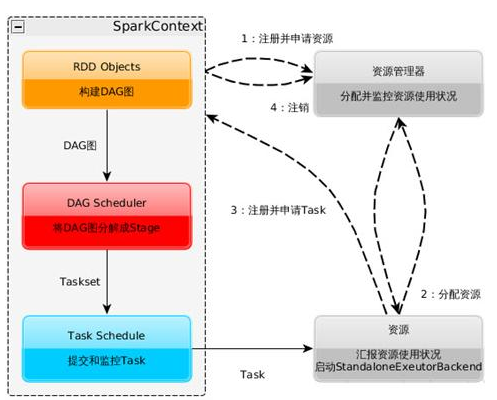
注意这里的StandaloneExecutorBackend是一个概念(我在spark项目中没找到),实际上的spark standalone的资源调度类是 CoarseGrainedExecutorBackend
1.构建Spark Application的运行环境(启动SparkContext),SparkContext向资源管理器(ClusterManager)(可以是Standalone、Mesos或YARN)注册并申请运行Executor资源;
2.资源管理器分配Executor资源并启动StandaloneExecutorBackend,Executor运行情况将随着心跳发送到资源管理器上;
3.SparkContext构建成DAG图,将DAG图分解成Stage,并把Taskset发送给Task Scheduler。
Executor向SparkContext申请Task,Task Scheduler将Task发放给Executor运行同时SparkContext将应用程序代码发放给Executor。
4.Task在Executor上运行,运行完毕释放所有资源。
2.3相关的类:
ExecutorBackend:
特质签名(Executor用来向集群调度发送更新的插件)

各种运行模式的类图:
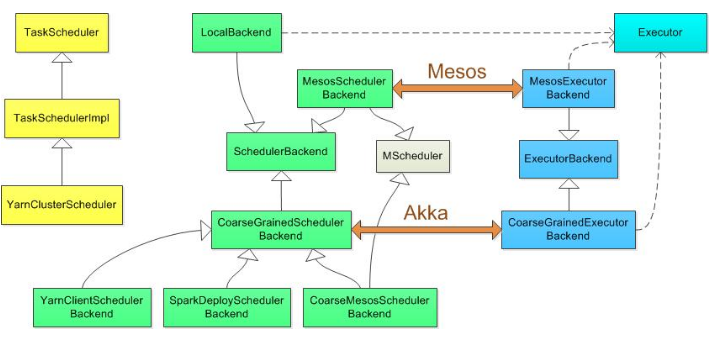
其中standalone是用SparkDeploySchedulerBackend配合TeskSchedulerImpl工作,相关类图应该是:
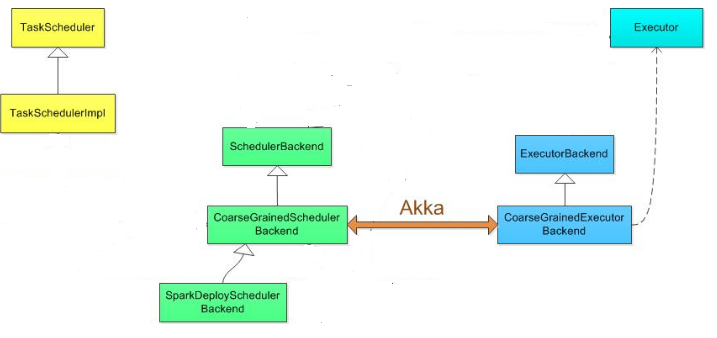
SchedulerBackend特质(核心函数:reviveOffers())
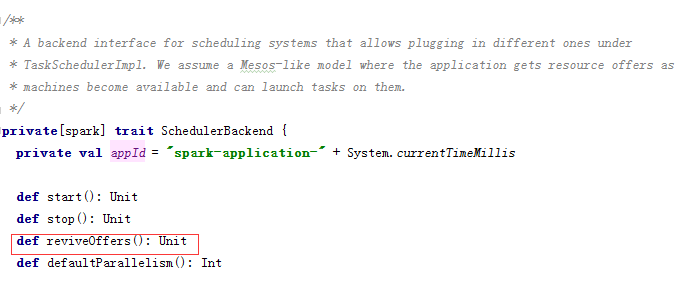
CoarseGrainedExecutorBackend(receive方法里是若干模式匹配,类似于switch case,根据相关模式执行相应操作。主要有注册Executor,运行Task等)
override def receive: PartialFunction[Any, Unit] = {
case RegisteredExecutor(hostname) =>
logInfo("Successfully registered with driver")
executor = new Executor(executorId, hostname, env, userClassPath, isLocal = false)
case RegisterExecutorFailed(message) =>
logError("Slave registration failed: " + message)
exitExecutor(1)
case LaunchTask(data) =>
if (executor == null) {
logError("Received LaunchTask command but executor was null")
exitExecutor(1)
} else {
val taskDesc = ser.deserialize[TaskDescription](data.value)
logInfo("Got assigned task " + taskDesc.taskId)
executor.launchTask(this, taskId = taskDesc.taskId, attemptNumber = taskDesc.attemptNumber,
taskDesc.name, taskDesc.serializedTask)
}
case KillTask(taskId, _, interruptThread) =>
if (executor == null) {
logError("Received KillTask command but executor was null")
exitExecutor(1)
} else {
executor.killTask(taskId, interruptThread)
}
case StopExecutor =>
stopping.set(true)
logInfo("Driver commanded a shutdown")
// Cannot shutdown here because an ack may need to be sent back to the caller. So send
// a message to self to actually do the shutdown.
self.send(Shutdown)
case Shutdown =>
stopping.set(true)
new Thread("CoarseGrainedExecutorBackend-stop-executor") {
override def run(): Unit = {
// executor.stop() will call `SparkEnv.stop()` which waits until RpcEnv stops totally.
// However, if `executor.stop()` runs in some thread of RpcEnv, RpcEnv won't be able to
// stop until `executor.stop()` returns, which becomes a dead-lock (See SPARK-14180).
// Therefore, we put this line in a new thread.
executor.stop()
}
}.start()
}
最后一个类SparkDeploySchedulerBackend(start):
var driverEndpoint: RpcEndpointRef = null
protected def minRegisteredRatio: Double = _minRegisteredRatio
override def start() {
val properties = new ArrayBuffer[(String, String)]
for ((key, value) <- scheduler.sc.conf.getAll) {
if (key.startsWith("spark.")) {
properties += ((key, value))
}
}
// TODO (prashant) send conf instead of properties
driverEndpoint = createDriverEndpointRef(properties)
}
protected def createDriverEndpointRef(
properties: ArrayBuffer[(String, String)]): RpcEndpointRef = {
rpcEnv.setupEndpoint(ENDPOINT_NAME, createDriverEndpoint(properties))
}
protected def createDriverEndpoint(properties: Seq[(String, String)]): DriverEndpoint = {
new DriverEndpoint(rpcEnv, properties)
}
2.4调度模块:
2.4.1作业调度简介
DAGScheduler: 根据Job构建基于Stage的DAG(Directed Acyclic Graph有向无环图),并提交Stage给TASkScheduler。 其划分Stage的依据是RDD之间的依赖的关系找出开销最小的调度方法,如下图

注:从最后一个Stage开始倒推,如果有依赖关系 就先解决父节点,如果没有依赖关系 就直接运行;这里做了一个简单的实验:Spark DAGSheduler生成Stage过程分析实验
2.4.2 任务调度简介:
TaskSchedulter: 将TaskSet提交给worker运行,每个Executor运行什么Task就是在此处分配的. TaskScheduler维护所有TaskSet,当Executor向Driver发生心跳时,TaskScheduler会根据资源剩余情况分配相应的Task。
另外TaskScheduler还维护着所有Task的运行标签,重试失败的Task。下图展示了TaskScheduler的作用

在不同运行模式中任务调度器具体为:
- Spark on Standalone模式为TaskScheduler
- YARN-Client模式为YarnClientClusterScheduler
- YARN-Cluster模式为YarnClusterScheduler
3.运行模式
3.1 standalone模式
- Standalone模式使用Spark自带的资源调度框架
- 采用Master/Slaves的典型架构,选用ZooKeeper来实现Master的HA
- 框架结构图如下:
![]()
- 该模式主要的节点有Client节点、Master节点和Worker节点。其中Driver既可以运行在Master节点上中,也可以运行在本地Client端。当用spark-shell交互式工具提交Spark的Job时,Driver在Master节点上运行;当使用spark-submit工具提交Job或者在Eclips、IDEA等开发平台上使用”new SparkConf.setManager(“spark://master:7077”)”方式运行Spark任务时,Driver是运行在本地Client端上的
- 运行过程如下图:(参考至)
![]()
- SparkContext连接到Master,向Master注册并申请资源(CPU Core 和Memory)
- Master根据SparkContext的资源申请要求和Worker心跳周期内报告的信息决定在哪个Worker上分配资源,然后在该Worker上获取资源,然后启动StandaloneExecutorBackend;
- StandaloneExecutorBackend向SparkContext注册;
- SparkContext将Applicaiton代码发送给StandaloneExecutorBackend;并且SparkContext解析Applicaiton代码,构建DAG图,并提交给DAG Scheduler分解成Stage(当碰到Action操作时,就会催生Job;每个Job中含有1个或多个Stage,Stage一般在获取外部数据和shuffle之前产生),然后以Stage(或者称为TaskSet)提交给Task Scheduler,Task Scheduler负责将Task分配到相应的Worker,最后提交给StandaloneExecutorBackend执行;
- StandaloneExecutorBackend会建立Executor线程池,开始执行Task,并向SparkContext报告,直至Task完成
- 所有Task完成后,SparkContext向Master注销,释放资源
4 RDD实战
sc.makeRDD(Seq("arachis","tony","lily","tom")).map{
name => (name.charAt(0),name)
}.groupByKey().mapValues{
names => names.toSet.size //unique and count
}.collect()
提交Job collect

划分Stage

提交Stage , 开始Task 运行调度
Stage0的DAG图,makeRDD => map ; 相应生成了两个RDD:ParallelCollectionRDD,MapPartitionsRDD
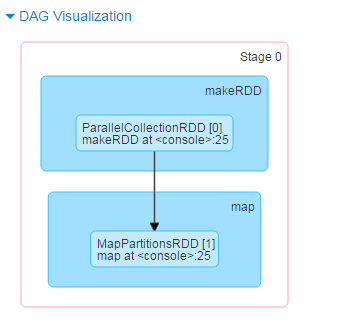
Stage1 的DAG图,groupByKey => mapValues; 相应生成两个RDD:ShuffledRDD, MapPartitionsRDD
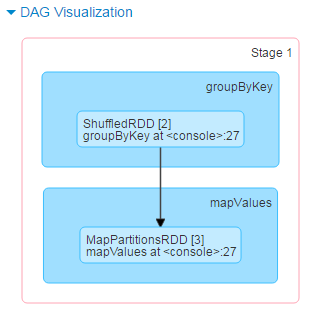
- 将这些术语串起来的运行层次图如下:
![]()
- Job=多个stage,Stage=多个同种task, Task分为ShuffleMapTask和ResultTask,Dependency分为ShuffleDependency和NarrowDependency
链接:
Spark官网:http://spark.apache.org/docs/latest/cluster-overview.html
http://www.cnblogs.com/tgzhu/p/5818374.html







 浙公网安备 33010602011771号
浙公网安备 33010602011771号